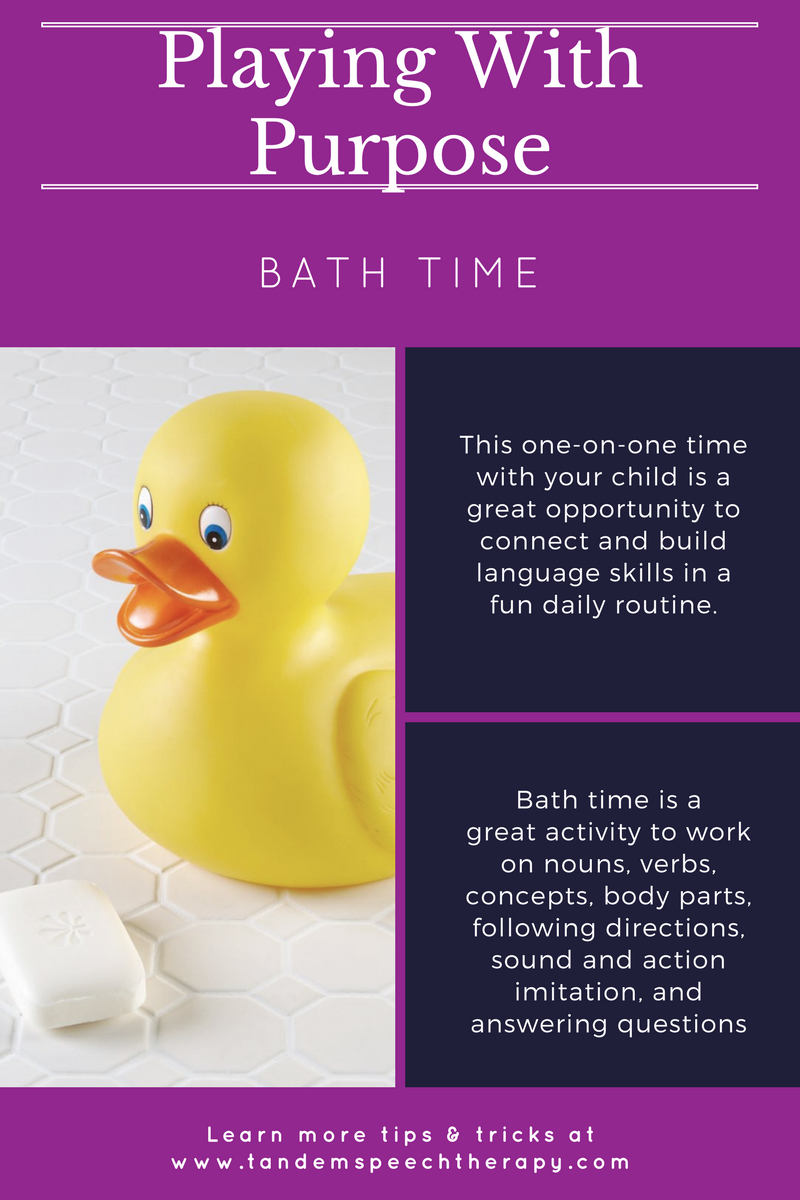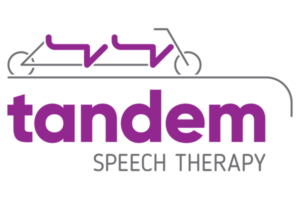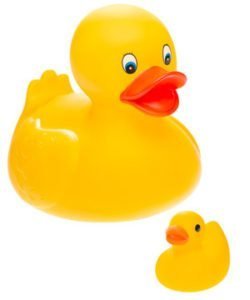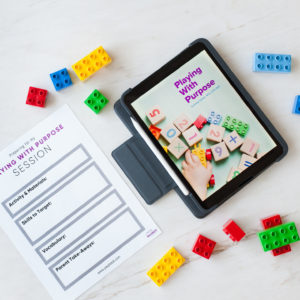One of the most effective ways to build language is during routines, especially routines that occur every day. That’s why bath time is a great opportunity for you to connect with your child to build language. Bath time is a beloved activity for many children. It’s easy to incorporate Playing With Purpose and sneak in many language building interactions without your child ever realizing they are ever doing “work”.
This one-on-one time with your child is a great place to highlight every day language skills. Some of my favorite vocabulary words to use during bath time are:
- water
- towel
- bubbles
- wash
- pour
- bath(tub)
- soap/shampoo
- wet/dry
- in/out
- toy names
- body part names

Bath time is great because you do not necessarily have to go out and buy anything new or specific. And as a bonus, bath time is something that is already part of your day so no need to build in extra time to sit on the floor and play.
On the off chance your child is not a water baby, then books about bath time provide opportunities to introduce new words and concepts in a less stressful environment. You can use the books as a tool to talk about how much fun the characters are having during their bath time to help easy your little ones fears.
Top 5 Tips for Playing With Purpose During Bath Time
- Bath time is an opportunity to incorporate descriptive language when you play a game called “sink or float”. Gather up a bunch of items from around the house that you do not mind getting wet. Then try them out in the tub to see if they sink or float. Once you have done this with a few items your child can guess what is going to happen. This is a chance for them to practice making a prediction. Not only can you describe the color of the toys, but you can use “sink or float” to talk about: what shape the toy is, what material it is made of, and most importantly is it heavy or light.
- Joint attention is an incredibly important skill our children must develop. It’s the sharing of an experience between a child and their communication partner–in the case of bath time that is you, their parent. There are lots of things you can do during bath time to get your child’s attention. Try blowing bubbles, splashing water, or getting some multi-sensory bath toys. Also, try taking turns with your child. Wait for them to look at you which is an indication they want an activity to be repeated.
- The beauty of bath time is that it is a routine. Most likely you repeat the same sequence of events each time your child takes a bath. Talk about the steps he/she takes during bath time. This is referred to as using self-talk or parallel talk and is a great tool to model good vocabulary. Use vocabulary such as: first, next, and last to highlight sequential terms. When your child becomes familiar with the routine, have them dictate the steps to you as they are taking their bath. If sequencing is challenging, then there are lots of fun puzzles you can use to help your child learn the skills.
- The are tons of vocabulary words that are associated with bath time so it’s a perfect activity to use to expand your childs use of word combinations. If you hear you child say ‘wash’, then respond with an expanded phrase. You might say, “Yes, daddy is going to wash your hand.” Be sure to always include the word your child used, helping him/her to make the sentence more complete. Another example would be if your child said ‘on’ while you’re getting the bathtub ready. You could respond by say, “Okay let’s turn the water on.”
- Lastly, bath time provides a wonderful time for you to engage with your child and encourage imaginative play. Try giving your child just a simple plastic cup and seeing all the fun games you can create together. Maybe your child turns the cup into a boat or a submarine. Then ask you child questions about the world he/she is creating. Let your inner child come out and play along with him/her.
Bath time is just one of many daily routines you and your child engage in throughout your days. Snack and meal time, getting dressed, brushing teeth, preparing to go to bed, and getting ready for school are all routines you can encorporate language learning opportunities into. Take a few minutes to think about how you and your child are Playing With Purpose throughout your day. It might surprise you or you may discover a new moment to spark some language.
Start Playing With Purpose
Learn how to purposefully and intentionally interact with your child during play and help them increase opportunities for speech and language development with our Playing with Purpose book!












